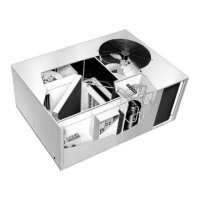Page 43
IV-PLACEMENT AND INSTALLATION
Make sure that the unit is installed in accordance with the
installation instructions and all applicable codes. See acĆ
cessories section for conditions requiring use of the optional
roof mounting frame (RMF16).
V-ELECTRICAL CONNECTIONS
A-Field Wiring
Unit and optional thermostat field wiring is shown in the unit
diagram section of this manual.
B-Power Supply
Refer to startĆup directions and refer closely to the unit wirĆ
ing diagram when servicing. Refer to unit nameplate for
minimum circuit ampacity and maximum fuse size. 208 volt
units are field wired with red wire connected to control transĆ
former primary. 230 volt units are factory wired with orange
wire connected to control transformer primary.
DANGER
All single phase units use single
pole contactors. One leg of comĆ
pressor, capacitor and condenser
fan are connected to line voltage
at all times.
Remove all power to disconnect
before servicing.
Electrical shock resulting in
death or injury may result if power
is not disconnected.
VI-STARTĆUP - OPERATION
A-Crankcase Heaters
Crankcase heaters must be energized for 24 hours before atĆ
tempting to start compressors. Set thermostat levers so there
is no demand to prevent compressor from cycling. Apply powĆ
er to unit.
B-Preliminary Check
1- Make sure refrigerant lines do not rub against cabinet or
against each other.
2- Inspect all electrical wiring, both factory and field
installed, for loose connections.
3- Check voltage at the disconnect switch. Voltage must
be within range listed on unit nameplate. If not, consult
power company and have voltage condition corrected
before starting unit.
4- Recheck voltage with unit running. If power is not within
range listed on unit nameplate, stop unit and consult
power company. Check amperage of unit. Refer to unit
nameplate for correct running amps.
5- Make sure filter is in place before start-up.
VII-COOLING SYSTEM SERVICE CHECKS
WARNING
Refrigerant can be harmful if it is inhaled. Refrigerant
must be used and recovered responsibly.
Failure to follow this warning may result in personal
injury or death.
The charge should be checked during startup using the
method outlined below.
A-Gauge Manifold Attachment
Service gauge ports are identified in figure NO TAG. Attach
gauge manifold high pressure line to liquid line gauge port.
Attach gauge manifold low pressure line to suction line
gauge port.
B-Cooling Sart Up
1- Set thermostat system switch in Cool" position, fan switch
in On" or Auto" position and adjust room thermostat to a
setting below room temperature.
2- Close unit disconnect switch.
3- Compressor will start and cycle on thermostat demand.
C-Three Phase Compressor Rotation
Three phase scroll compressors must be phased sequenĆ
tially to ensure correct compressor rotation and operation.
At compressor startĆup, a rise in discharge and drop in sucĆ
tion pressures indicates proper compressor phasing and
operation. If discharge and suction pressures do not funcĆ
tion normally, follow these steps:
1- Disconnect power to the compressor and the unit.
2- Reverse any two field power leads to the unit.
3- Reapply power to the compressor and unit.
Discharge and suction pressures should operate at their
normal startĆup ranges.
NOTE - The compressor noise level will be significantly
higher when phasing is incorrect and will not provide cooling
when operating backwards.
D-Charging
It is not recommended that the system be charged below
60° F (15° C). If charging below 60° F (15° C) is required or if
system is completely void of refrigerant, the recommended
and most accurate method of charging is to weigh the refrigĆ
erant into the unit according to the amount shown on the unit
rating plate. If weighing facilities are not available or if unit is
just low on charge, use the following procedure:
Charging must be done in cooling mode. Operate unit and alĆ
low system pressures to stabilize before and after each adjustĆ
ment. Make sure all outdoor air dampers are closed.

